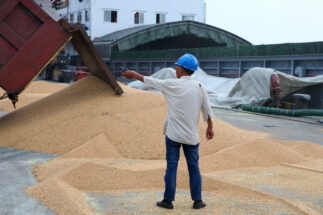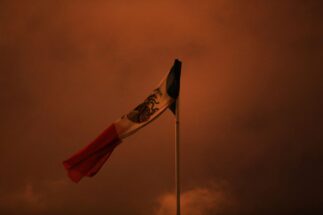The alarm bells were already ringing. Recent years have seen several scientific studies warn of the Amazon reaching a point of no return, due to high rates of deforestation and degradation. Now, another report has cautioned that, in less than three years, the world’s largest tropical forest could reach an irreversible tipping point that will lead to its progressive death – and increasing releases of carbon emissions that could destabilise the planet’s climate and efforts to mitigate global warming.
26%
of the Amazon’s area has now been deforested or degraded, according to a new report by the Amazon Network of Georeferenced Socio-environmental Information (RAISG)
In early September, as the Fifth Amazon Summit of Indigenous Peoples took place in Lima, a new report, “Amazonia Against the Clock”, was released, providing a regional assessment on how to protect 80% of the Amazon by 2025. And the results are worrying, even pessimistic.
An initiative of the Amazon Network of Georeferenced Socio-environmental Information (RAISG), it revealed that deforestation and degradation have now touched 26% of the entire Amazon region, according to data from 1985 to 2020. Of that percentage, 20% – an area three times the size of France – has been transformed irreversibly, mainly into cropland or pastures for livestock.
Some observers, such as Ernesto Ráez Luna, an ecologist and executive director of the Instituto del Bien Común in Peru, feel the deadlines for avoiding a tipping point may have already passed. “2025 is not a deadline, but more a reflection of the urgency to take strong action,” he told Diálogo Chino. “The ‘point of no return’ implies a gigantic release of emissions that will derail any human effort to stop catastrophic climate disruption.”
Indeed, some areas of the Amazon, particularly in Brazil, are already emitting more carbon than is sequestered, according to a study published in Nature last year.
We need another economic model that respects life. If we don’t do this, we are condemning ourselves to extinction
In this context, the protection of the Amazon is more urgent than ever, according to the Coordinator of Indigenous Organizations of the Amazon River Basin (COICA), which represents 511 indigenous groups from the nine Amazonian countries. The body has led calls to protect 80% of the forest and avoid the tipping point. This goal was also echoed at last year’s congress of the International Union for Conservation of Nature (IUCN), from which the Amazon for Life coalition emerged, with the express aim of protecting 80% of the biome by 2025.
“We want to make a breakthrough because the governments are not going to meet the 2030 goals, then they will say 2060, and then there is no more time,” José Gregorio Díaz Mirabal, coordinator of COICA, told Diálogo Chino, referring to the sluggish pace of climate negotiations. “We want to protect 80% of the Amazon and, for that, we need another economic model that respects and allows life. If we don’t do this, we are condemning ourselves to extinction.”
The agony of the Amazon
Brazil and Bolivia alone are responsible for 90% of Amazon deforestation and degradation, according to the “Amazonia Against the Clock” report. In both countries, there has been significant savannisation – the transformation of tropical forests into savannah-like environments – with 34% of the Brazilian Amazon and 24% of the Bolivian side having been transformed.
Adding to the degradation are fires. This August, Brazil registered a new record for forest fires, with the highest number of blazes recorded in the month in the past 12 years, according to its National Institute for Space Research.
“Although indigenous peoples do not have national budgets, their livelihoods and the way they look at the Amazon have had a very positive impact on its conservation,” said Quintanilla, who is director of research and knowledge management at the Friends of Nature Foundation.
However, indigenous territories are not exempt from threats. The expansion of the agricultural frontier – one of the main causes of deforestation – within indigenous lands grew by 160% and 220% in protected areas between 2001 and 2018, the report reveals.
Indigenous peoples’ livelihoods and ways of seeing the Amazon have had a very positive impact on its conservation
On top of the damage of these incursions, the Peruvian and Brazilian Amazon are the areas of the biome with the highest risk and incidence of murders of indigenous leaders and defenders, according to Global Witness. In 2020, three out of four crimes against environmental defenders took place in the Amazon region of both countries, which have yet to ratify the Escazú Agreement.
“The Amazon basin has been the target of many governments that use it as a bargaining chip, such as the current one in Brazil,” said Angela Kaxuyana of the Coordination of the Indigenous Organizations of the Brazilian Amazon (COIAB), during a presentation on the release of the new research. “The lack of awareness of indigenous peoples and the exchange of our territories has also caused the death of those who defend the Amazon – a massacre that we cannot continue to allow.”
Kaxuyana’s comments came after the murder of two Guajajara defenders in the Brazilian state of Maranhão in the first week of September.
Latent threats
Although agricultural activity – in particular cattle ranching – remains the main driver of deforestation, 66% of the Amazon is subject to other types of “fixed or permanent pressures”, according to the RAISG study. These include mining, the oil industry, hydroelectric plants and road construction. “Although these [individual projects] are generating changes that cannot be detected in such a deep way by satellite images, as a whole they are creating permanent pressure,” said Quintanilla.

Oil blocks occupy just over 9% of the Amazon, an area of 80 million hectares, almost twice the size of Japan. The most worrying case is Ecuador, where more than half of its Amazonian forests are occupied, or destined to be occupied, by oil blocks, from which nearly 90% of the crude oil exported from the Amazon comes, with its main destination the United States. It is followed by Peru, with oil fields covering 31% of its area, Bolivia with 29% and Colombia with 28%.
The Ecuadorian Amazon – which represents only 2% of the biome’s area – also concentrates 18% of hydroelectric plants, a percentage only surpassed by Brazil, which is home to half of the plants. “Hydroelectric plants exert a very important pressure because they completely change the natural water dynamics, to which must be added the network of roads that has been increasing, further fragmenting ecosystems,” Quintanilla said.
In this respect, ecologist Ráez Luna emphasised that the Amazonian countries “must abandon these investment projects for the penetration and exploitation of hydrocarbons”.
“We must repel the active destructive processes in the Amazon, such as the criminal quadrangle of gold mining, illegal logging, wildlife trafficking and drug trafficking,” he added.
Titling of disputed territories
To avoid reaching a point of no return, the RAISG report proposes a series of solutions, chief among them guarantees for the rights of indigenous peoples, and the recognition and titling of 100 million hectares of their territories that are disputed, declared or still in the process of identification.
48%
of the Amazon is either a protected area or recognised indigenous territory. However, 86% of deforestation occurs outside these areas, highlighting the need to expand protections
Protected areas and indigenous territories currently cover – and safeguard – half of the Amazon. However, the other half have no designation whatsoever and are in danger of disappearing. According to the report, undesignated areas register the highest levels of transformation and degradation, with rates up to eight times higher than in indigenous territories.
For Díaz Mirabal, COICA coordinator and leader of the Wakuenai Kurripaco ethnic group in Venezuela, titling is a moral and environmental obligation to all of humanity. “The Science Panel for the Amazon and other studies are saying that 80% of the best conserved ecosystems on the planet are in our territories. So what else are countries waiting on to start titling them?” Díaz told Diálogo Chino. “There is also a direct link between the destruction of our home and the assassinations of leaders, so the recognition of our rights is an urgent solution.”
Although land titling is imperative, according to ecologist Ráez Luna, it would not be sufficient on its own. “It is necessary to repair the damage already caused to the Amazon,” he said. The RAISG report also calls for the restoration of 6% of highly degraded lands, seen as vital in halting the current trend.
“Even many indigenous territories that are already titled but ecologically degraded, which no longer offer sufficient livelihoods for the well-being of the communities, must be restored,” Ráez Luna said.
Debt-for-nature swaps in the Amazon
Another of the solutions put forward by the coalition relates to the foreign debt of the nine countries that make up the Amazon. The proposal is to cancel the debt in exchange for a commitment to protect 80% of the Amazon forests – in other words, a debt-for-nature swap.

For Tuntiak Katán, COICA’s deputy coordinator, foreign debt systemically drives extractive activities and destruction throughout the region. “We propose debt cancellation as an immediate protective measure to alleviate the economic challenges our countries are facing,” he said. “Industrialised countries and international financial institutions would take responsibility for safeguarding the planet, mitigating climate change and relieving pressure on the Amazon.”
In Colombia, for example, a nation which hosts about 6% of the Amazon, swapping foreign debt for protection and restoration is already on the agenda of the new government of Gustavo Petro. For indigenous leaders, this is a sign of hope in the region. “In our countries we have many natural resources, but our children who are not even born yet already have foreign debt. The cancellation of the debt is a very old aspiration of Latin America,” said Díaz Mirabal.
In the same way, experts in Ecuador see debt-for-nature swaps as a viable option, adding that “its debt levels leave it tightly constrained in its ability to conserve these resources or develop sustainable uses for them.”
They also highlight the possibilities for creditors such as China – itself having made a discursive pivot towards “ecological civilisation” – to play a role in these potentially transformational exchanges: “If Ecuador and China agree to reorient public finance toward long-term resilience of the Ecuadorian Amazon, they can begin to build a post-petroleum future for the country, one based on the sustainable development of its vast natural resources.”








